
To guarantee the wide-scale success of any programme, collecting and analysing data becomes a poignant virtue. Introducing interventions and implementing modifications within Bal Raksha Bharat’s programmes have led to a larger success ratio through the Evidence & Use approach.
Bal Raksha Bharat was founded on the belief that every child has the potential to change the world; this is exactly what we aim to do through the Evidence & Use approach by understanding the impact of a programme and altering to ensure and sustain children’s overall growth and development.
At Bal Raksha Bharat, we are constantly engaged in channeling thought leadership and generating newer evidence to strengthen the agenda of children and their well-being. We partner with institutions of repute such as National Institute of Mental Health and Neurosciences (NIMHANS), National Institute of Disaster Management (NIDM), National Institute of Nutrition (ICMR-NIN) and others bolster and add value to our research work. Some of the key studies through which we have strengthened evidence for informed policy making and programming are listed below:
- State of India’s Newborns, 2014
- Care of Small & Sick Newborns in Special Newborn Care Unit of India, 2015 (In collaboration
with UNICEF) - School Closures and Mergers Study, 2017
- Right Start: Investing in Early Years of Education, 2018
- Early Childhood Education in five Indian States: A research study on co-location, 2019
- Study on Child Abuse, India, 2007
- Surviving the Streets: A Study on Street Children in Delhi, 2011
- WINGS: The World of India’s Girls, 2014 (Flagship Report)
- The Hidden Workforce: A Study on Child Labour in the Garment Industry in Delhi, 2015
- Caring for The Children in Street Situation: Good Practices and Approaches, 2016
- Life on The Street: Street Children Survey in 5 Cities: Lucknow, Mughalsarai, Hyderabad, Patna and Kolkata-Howrah, 2016
- WINGS: A Study on the Perception of Girls’ Safety in Public Spaces, 2018 (Flagship Report)
- A Study on Non-Discrimination in the Tsunami Rehabilitation Programme in India, 2006
- Making Space for Children, Post Disaster Reconstruction with Children and their Families, 2007
- Review of Disaster Management Policies and Practices, from a Child Rights Perspective in Andaman and Nicobar Islands, Tamil Nadu and Andhra Pradesh, 2008
- Spotlight on Invisibles (Mapping study of Children in Street Situations), 2019
- Child Rights Situation Analysis in collaboration with Joining Forces, 2019
- Generation at Stake: Protecting India’s Children from Impact of COVID-19, 2020
- Protect A Generation: Climate Security for India’s Children’ Report, 2020 (in collaboration with PWC India , Foundation)
- Climate Change and Children in India: Awareness and Participation 2021
- Cost of Universalising Early Childhood Education in India, 2021
- WINGS 2022: Spotlight on Adolescent Girls amid COVID-19, 2022
- The Rights and Agency of Children (TRAC) 2022: Spotlight on Mental Health and Psychosocial Well-being, 2022
- Child-Centred Humanitarian Response, Planning and Actions for Urban setting in India, 202








